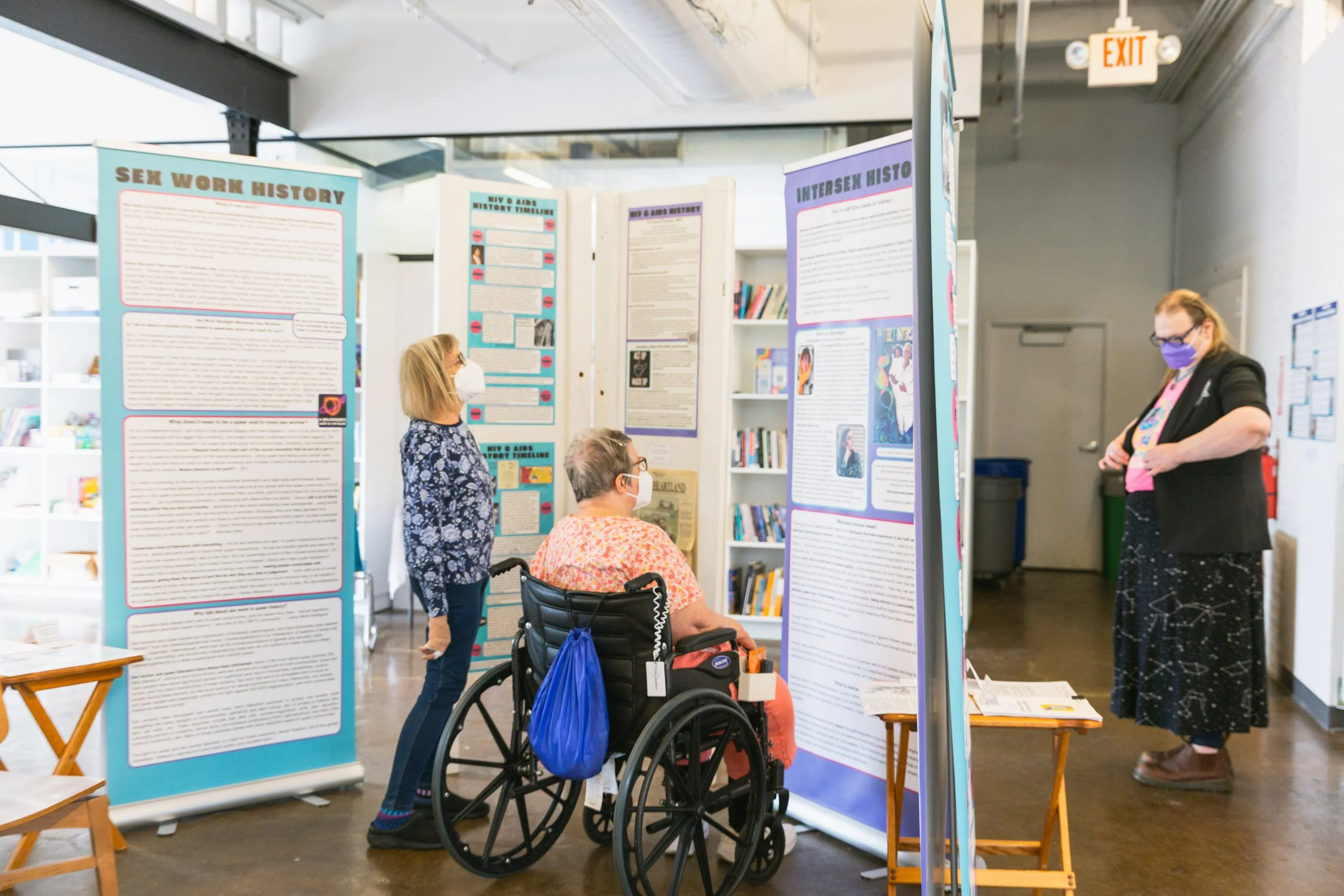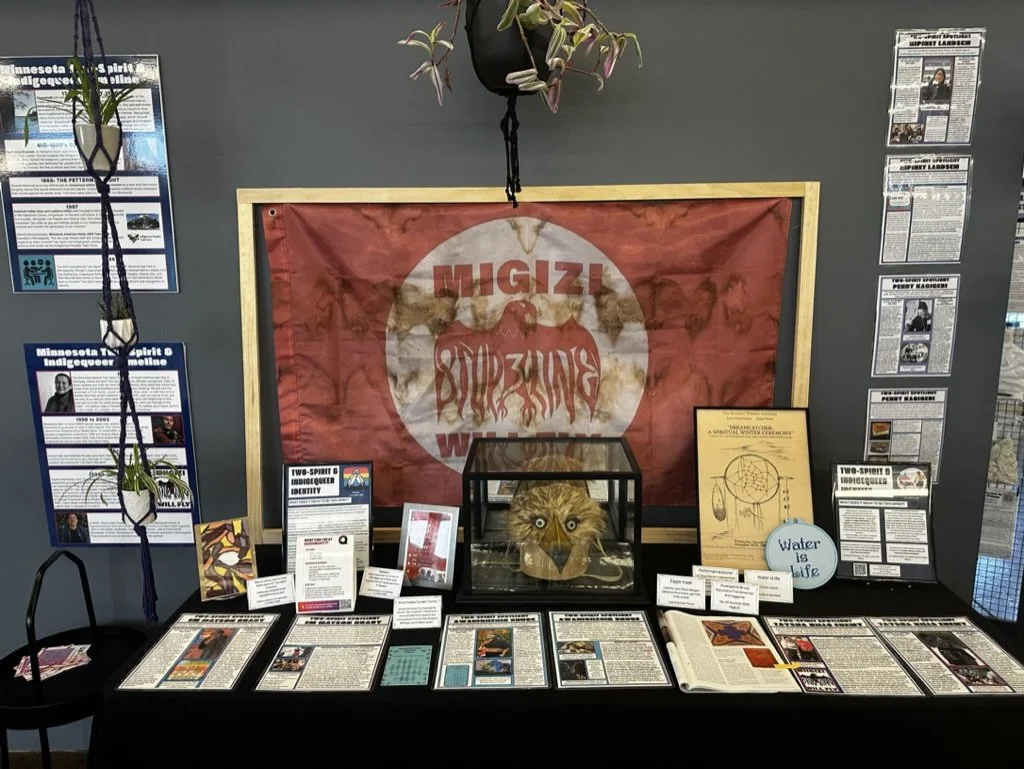
Standing queer history banners and banners; the centerpoint of We Live On. The banners have timelines, storyteller spotlights, and a brief overview of the four topics: queer Iron Range history, sex work in Minnesota, intersex history, and the history of Telling Queer History. The wooden display has two front-facing panels with HIV/AIDS Minnesota history, including an old newspaper with a feature on a couple during the HIV/AIDS crisis. There are two tv trays with documents and accompanying placards. The exhibit is displayed at Red Wing Arts’ gallery with lots of bright natural light. Researched by Mounica Kota.

Crankies are an old storytelling art form that utilizes long illustrated scrolls wound onto two spools. The spools are loaded into a box that has a viewing window.
Visitors could hand-crank this scroll to read the TQH paper timelines, which reference historical and personal events. You use the top left crank to read the scroll left to right. Once you reach the end, you use the right crank to scroll back to the beginning.
Made by Mona and Ben Welter, RJ Lawrence’s parents

Executive Director RJ Lawrence speaks to the audience at the Moorhead We Live On kick-off event at The Red Raven. Behind them is the ancestral altar, crankie, TV playing a TQH storyteller compilation, shelves with our Two-Spirit and Indigequeer display, and timelines, intersex flags, and storyteller spotlights on the walls.

In between the Iron Range & sex work banners is the Camp Migizi flag, displayed on the wall of Red Raven. This is the original flag that hung in the resistance camp from 2020-2022. Loaned by Taysha Kills Enemy.

Early Intersex flag, Designed in 2009 by Natalie Phox: It consists of five horizontal stripes coloured (from top to bottom) lavender, white, a double-width stripe with a gradient from blue to pink, white and lavender. The gradient represents the range of sexes between male and female, and the lavender represents a combination of male and female traits.
Intersex flag, Designed in 2013 by Morgan Carpenter: “The flag is comprised of a golden yellow field, with a purple circle emblem. The colours and circle don’t just avoid referencing gender stereotypes, like the colours pink and blue, they seek to completely avoid use of symbols that have anything to do with gender at all. Instead the circle is unbroken and unornamented, symbolising wholeness and completeness, and our potentialities. We are still fighting for bodily autonomy and genital integrity, and this symbolises the right to be who and how we want to be.” - Morgan Carpenter

1900's coal miner canary cages from Anthracite region. “As a result of our criminalization and the concurrent stigma that makes our work “illicit,” sex workers often refer to ourselves as the ‘canaries in the coal mine’ when it comes to matters of state violence. It’s a chilling analogy; the metaphorical miner’s survival depends not only on the canary’s death, but also on the miner’s perception of the canary’s death. The metaphor ultimately fails, for unlike miners taking heed of the canary’s abrupt silence, the general population treats sex workers with indifference at best. We’re more like the low-battery beep of a carbon monoxide detector, a sound somehow more irritating than the poison.” - Olivia Stone
Decriminalize sex work!
“The decriminalization of sex work repeals sex work-specific criminal and licensing laws. This framework recognizes sex work as work, and opens the sex industry’s access to the civil laws that protect and govern all other workforces. Civil laws protect people’s health, safety, privacy, autonomy, and human and industrial rights.” - Digital Realities: Sex Work // Internet // Governance Zine
Sex workers are often the canary in the coal mine for things that affect everyone eventually. Learn about what sex workers want, why they want it, and how important it is to support them.

This altar is a dedicated space created to honor and remember our 2SLGBTQIA+ community members who have passed away, those known and unknown. By displaying personal items, photos, flowers, candles, food, and other symbolic objects representing their lives, we can connect to those who came before us and those who were taken from us too soon.
Altars can be used as a space to meditate, pray, celebrate our loved ones, recall memories, ask for guidance, and process our grief. You can also write a letter to a queer ancestor! Your ancestors could be known friends or family members who have passed away. It can also include queer & trans community members that you’ve never met, many of whom have been lost to violence, some whose names we may never know. All of our ancestors are honored here.
Some letter ideas: Express gratitude or other feelings, share what you miss about them, ask questions, seek wisdom, acknowledge their impact !

Using the fabric markers provided, attendees drew or wrote about what queer community looks like for them. Now that we’ve collected the artwork from all 5 exhibits, local quilters are creating a unique design with the individual squares that will be sewn together to create one big Telling Queer History quilt to be displayed at Queermunity in fall 2025 and later given to its forever home at Queerspace Collective. There was also a guest book for participants to sign, as well as a display featuring numerous queer zines.

A participant reads the Iron Range banner at the Grand Rapids exhibit. The banners were set up near the railings in the Old Central School.



Attendees view the history display at Queermunity

Two-Spirit & Indigequeer exhibit table at Queermunity featuring timelines, storyteller spotlights, art, embroidery, and an eagle mask.
Eagle mask made by Larry Cloud-Morgan, Ojibwe spiritual leader, gay man, artist, activist. Loaned by Erika Thorne

